|
Here, a little later than we had intended, are the answers to the game picture quiz in our last post. So as not to spoil, the key is behind this link.
0 Comments
In anticipation of our upcoming exhibit It's Your Move: The Games We Play, we've prepared a puzzle for you. This is the background image for the exhibit's publicity; twenty-five games and game systems are represented in this photograph. How many of them can you recognize? (Click on the image for a higher-resolution version.)
That ‘70s Exhibit will run through January 10, 2016 at Museum on Main.
 “Same Halls, Different Centuries” Amador Valley High School. Probably one of the oldest and most cherished parts of historic Pleasanton. As we look back over the years, it is quite obvious that the school has changed in many, MANY ways. From looking through the 1964 yearbook of Amador, it was quite shocking for me how different things had actually been, but I did manage to find some similarities. For example, as shown in this picture above, this is the same hallway in front of the main office that is still there today. This is the corridor that I use to get to my biology class every day! It really astonishes me of how 50 years ago, students just like me were walking through the very same halls, trying to find their biology classes. It’s just another way to show that we are the hometown originals. Of course, not everything was the same. Let’s look at the cheerleaders. Currently, in the 2013-2014 Varsity cheerleading squad, there are at least 15-20 girls. On the Junior Varsity there are at least 14-18 girls. Now, these numbers are not exact but they are very close. In the 1963-1964 school year (photos below), there were five varsity cheerleaders, one of whom was male. There were three Junior Varsity cheerleaders. Also, there was an additional team called the Pom Pon Girls which consisted of 5 girls, all of whom cheered with pom-pons. Now that’s what you call a change over 50 years. -Sruti, Jr. Volunteer Student Blogger 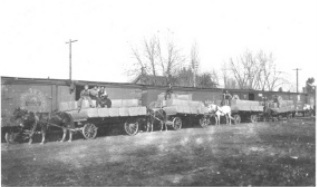 Hop wagons at the Pleasanton S.P. Station, ca. 1880. Hop wagons at the Pleasanton S.P. Station, ca. 1880. Museum on Main collection. In the mid-1880s, California had a significant population of itinerant farm laborers drawn from the population of recent immigrants (Chinese and European), from unemployed urban laborers, and from farmers who had lost their lands to bankruptcy and drought. As the railroad hub of an agricultural community, Pleasanton saw its share of transients come through town--and not everyone trusted them, certainly not the editors of the Pleasanton Star: A SOCIAL CRISIS There is no doubt but that we are on the verge of a crisis, that will require the united efforts of our citizens, and law to keep within bounds. Within ten days the warehouses at Niles and Milpitas have been burned down by tramps. About the same time an organized attempt was made to fire San Jose. We have four warehouses in Pleasanton either of which is liable to be fired any night. We have no protection of any kind. All four could be set on fire at the same time. Thousands of dollars worth of property is thus at the mercy of the fire fiends. That there is an organized band of those fellows there is no doubt. If caught the red tape of the law will never punish them; or will be so slow about it that the crime will be forgotten ere the wretches are brought to justice. Under such circumstances we believe if these human vampires were caught at their devilish work, Judge Lynch should speedily dispose of them. Hanging is too good for such wretches. [6/6/1885] In the San Jose incident mentioned, the Pacific Rural Press of June 13 noted that The wretched incendiary captured at San Jose has confessed the kindling of the then in that vicinity upon which we commented last week. He states that his motive was just that which we surmised would actuate such deeds, and that is an outcast's discontent, wrought to desperation by the communistic oratory of a demagogue. It is not clear whether the arsonist in the San Jose case was ever linked to an organized band of anarchists threatening the property-holders of the Santa Clara and Amador-Livermore Valley. Readers with further information are invited to reveal their findings in the comments.  Pleasanton teachers in a drag can-can sketch, 1958 Scholarship Frolics. Pleasanton teachers in a drag can-can sketch, 1958 Scholarship Frolics. From 1953 until at least 1963, the Amador Valley Teachers' Association sponsored an annual variety show to benefit its scholarship fund, which each year was awarded to an Amador graduate studying to become a teacher. These Scholarship Frolics consisted mostly of sketch comedy and musical numbers performed by local fraternal and charitable organizations--as well as students and faculty from the Valley's schools. 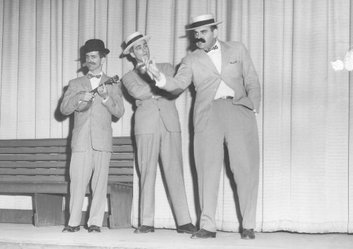 Sketch from the 1954 Scholarship Frolics. Ken Scullin at left. Sketch from the 1954 Scholarship Frolics. Ken Scullin at left. Pleasanton Times, March 11, 1954 Scholarship Frolic Show Slated Mar. 25 Selection of positions in the program for the annual Scholarship Frolic to be presented at the Amador Valley High School Auditorium March 25 will be made at a meeting of the committee and representatives of each participating organization to be held at Amador High tonight. The Scholarship Frolic is presented annually by the Amador Valley Teachers Association for the purpose of raising funds to be given an Amador High graduate who is to take teacher's course in a college of their choice. Last year's scholarship was awarded to Barbara York, who is now attending Whitman College at Walla Walla, Washington. The organization presenting the winning skit will be awarded the "Scholly Cup," which they will keep until next show. If an organization wins the cup three successive years it may keep the cup permanently. The cup was won last year by the Druids Circle. Among the organizations taking part in the program are Veterans of Foreign Wars Auxiliary, What's My Line; Druids Circle, This is Your Life; Rebekahs, I've Got a Secret; Native Sons, Perry Como Show; Lions, Drama in Mudville. The Sunol Community Club is also entering a skit. 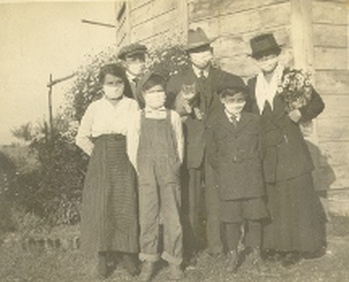 The Del Perugia family protects themselves against flu, 1918 The Del Perugia family protects themselves against flu, 1918 In the winter of 1919-20, the Spanish Flu epidemic that had begun in January 1918 was still rampaging around the globe; by the end of 1920 it would kill as many as 50 million people worldwide. Although Pleasanton was still a farming town with a population of fewer than 500 residing within the town limits (1100 if one counts unincorporated parts of the township), it was still vulnerable to the outbreak--in part because of the town's position on a railway line. The end of January brought a fresh outbreak, and Pleasanton's government and citizens responded with the best tools at their disposal. A safe and effective flu vaccine would not be developed until the 1940s, so the primary response was to minimize contact, keeping people out of enclosed public spaces such as schools and theaters. Pleasanton Times, 31 Jan. 1920  The Amador High class of 1931 as juniors in June of 1930. First in a series of windows into the Valley's everyday past. From the Pleasanton Times, December 12, 1930 Old Clothes Day Is To Be Held By Students Friday Parade Through City Is Planned For About Noontime People of Pleasanton do not want to think that all the hoboes have come to town, or that we have returned to the gay nineties along about noon today when they see a conglomeration of young people parading Main St, for it will be only the annual Old Clothes Day celebration of the students of the Amador Valley High School. The students will be arrayed in the oldest and funniest costumes which they could procure. The parade will start from the high school at 11:45 o'clock and will follow a line of march thru the main streets of the city. The school band will lead the procession. After the return to the school the students will be the guests of the sophomores and freshmen at a bean feed. Immediately following the dinner there will be a grand march in the gymnasium at which time the faculty, acting as Judges, will select the best and funniest costumes. As an aftermath the athletic board will award the block A to members of the football [s]quad. Following there will be a Christmas program put on by the Girls' League. The entertainment will be as follows: Song: “Deck the Halls with Holly," by everyone; song: "Just an Old Woman," by Melva Madsen; short play: "Light House Tragedy," by six of the girls; a stunt by group of girls; a selection of Latin songs by the Latin class; a reading, "Three Wise Men," by Olive Tripp; song: "Hark the Heralds Angels Sing," by everyone; song: "Rendevous," by Mildred Enos; Christmas selections by the orchestra; presentation of a Christmas picture.  Who Knew? This valley we live in is filled with historical surprises. Did you know that this valley was called Valle de San Jose and it was the principal pasture for the Mission San Jose? Over 30,000 head of cattle roamed the hills eating the grass. The round up would take place in a valley called Tassajera (which meant bowl-shaped) once a year and the meat, hides, tallow and the bones from the cattle would brought to the Mission. There it would be processed and then taken to ships waiting in the Bay. The meat and other by-products were sent to many parts of the world. Find out more about this intriguing valley by visiting the Museum on Main. See the exhibts and visit the books store to buy books that give you all kinds of history about where we live. |
AuthorJim DeMersman Archives
December 2016
Categories
All
|
Museum on Main 603 Main Street Pleasanton, CA 94566 -- 925.462.2766 -- www.museumonmain.org



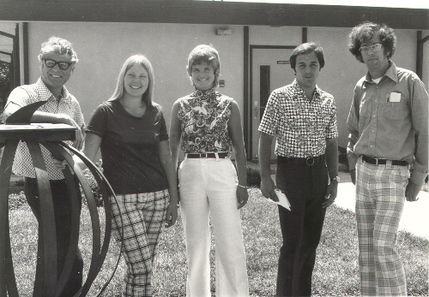

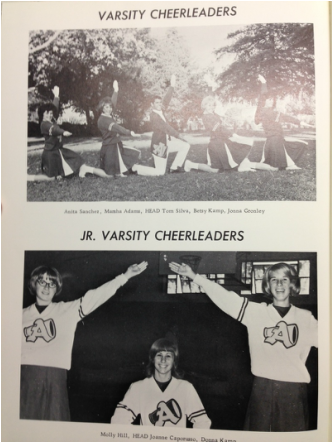
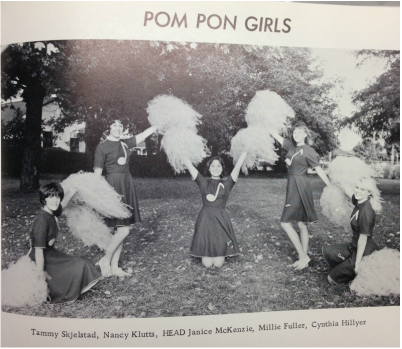
 RSS Feed
RSS Feed